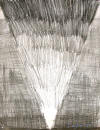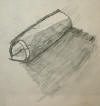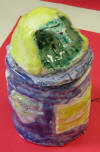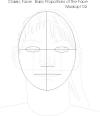|
| |
|
Lesson List:
Click on the title of a lesson to see it's overview. |
|
Value Scale |
Value Wedge |
Rolled Tube Dwg. |
Opened Roll Dwg |
|
Folded Paper Dwg |
Bottle Drawings |
Squaring Up Exercise |
Squared-Up Frog |
|
Church Drawing |
Egyptian Clay Bowls |
HS
Intro |
Animated Storybook |
| Logo
Web Quest |
Logo
Design |
Magazine Ad |
|
|
| Title: Value
Scale |
 |
| Grade Level: 6 |
|
Goals/Objectives (from Graded Course of Study):
22.g. VALUE
27.f.
Demonstrates ability to use standard techniques effectively for Pencil/pen and
ink |
|
Artistic/Occupational Influence: A good grasp of value is essential to
understanding shading and creating 3 dimensional form. |
|
Strategies (to meet needs of different learning styles): Some kids will find
it easier to put down an overall tone, then erase to create the lighter
areas. |
|
Activities (Step by Step):
Give the students a sheet of 9
x 12" paper.
Have them draw a shape
which takes up roughly 2/3 of the paper.
Have them divide the shape
in half, divide these halves in half, and divide these portions in half, so
that the shape is divided into 8 even steps.
The left end of the value
scale should be white, the right end of the value scale should be black, in
between each step should become progressively and evenly darker going from
white to the darkest black they can create.
Care should be given to
make each section evenly shaded and the overall shape should be neat. |
|
Evaluation:-each step should evenly move from light to dark
--no two sections should be
the same
--each section should be
evenly shaded throughout the section. |
|
Follow-Up: Subsequent projects will continue this investigation. |
| Title:Value
Wedge |
 |
| Grade Level: 6 |
|
Goals/Objectives (from Graded Course of Study):
22.g. VALUE
27.f.
Demonstrates ability to use standard techniques effectively for Pencil/pen and
ink
|
|
Artistic/Occupational Influence: A good grasp of value is essential to
understanding shading and creating 3 dimensional form. |
|
Strategies (to meet needs of different learning styles): Some kids will find
it easier to put down an overall tone, then erase to create the lighter
areas. |
|
Activities (Step by Step):
Students should be given a
9 x 12" sheet of paper.
A dot should be placed at
the bottom of the paper in the exact center.
A triangle should be drawn
from the upper left and right corners down to the center bottom dot.
This will give three
triangles.
The bases of the triangles
should be shaded black, the tips will be white, in between the student
should fade the values from dark to white as evenly as possible.
|
|
Evaluation: Grades
will be based on how evenly the values shift from black to white and how
neatly this is done. |
|
Follow-Up: Several projects will investigate value further. |
| Title: Rolled
Tube Drawing |
 |
| Grade Level: 6 |
|
Goals/Objectives (from Graded Course of Study):
3. Identifies
subject matter of art work: Still Life
14. Evaluates
own art work
22.g. VALUE
23.
Demonstrates the ability to use elements of art in original work
25.c.
Contrast
25.d.
Proportion/Distortion
26.a.
Demonstrates ability to produce Drawings
27.f.
Demonstrates ability to use standard techniques effectively for Pencil/pen and
ink
28.
Demonstrates knowledge of standard techniques in creating one-and two-point
perspective and depth
29.
Demonstrates ability to represent an object from various points of view
|
|
Artistic/Occupational Influence: Fundamental representational art. |
|
Strategies (to meet needs of different learning styles): n/a |
|
Activities (Step by Step): Students will be given a rolled piece of
poster board, two 12 x 18" pieces of white sulphite paper, and a pencil.
The students will place the rolled poster board on one piece of paper, and
will draw on the other. The poster tube should be positioned at a 45
degree angle from the viewer, so the opening and one side may be seen.
Students will then create a contour drawing showing the perspective and
proportions as seen in real life. When the contour drawing is
completed, shading will be added to make the tube appear 3 dimensional.
Care should be taken to show all the subtle shifts in value evident in the
real scene. |
|
Evaluation: Drawings will be judged on the effectiveness of the
contour drawing and the attention to subtle details while shading. |
|
Follow-Up: Subsequent drawings will deal with these same concepts. |
| Title:Open
Tube Drawing |

 |
| Grade Level: 6 |
|
Goals/Objectives (from Graded Course of Study):
3. Identifies
subject matter of art work: Still Life
14. Evaluates
own art work
22.g. VALUE
23.
Demonstrates the ability to use elements of art in original work
25.c.
Contrast
25.d.
Proportion/Distortion
26.a.
Demonstrates ability to produce Drawings
27.f.
Demonstrates ability to use standard techniques effectively for Pencil/pen and
ink
28.
Demonstrates knowledge of standard techniques in creating one-and two-point
perspective and depth
29.
Demonstrates ability to represent an object from various points of view
|
|
Artistic/Occupational Influence: Fundamental representational art. |
|
Strategies (to meet needs of different learning styles): n/a |
|
Activities (Step by Step): Students will be given a U-shaped piece of poster
board, two 12 x 18" pieces of white sulphite paper, and a pencil. The
students will place the poster board on one piece of paper, and will draw on
the other. The poster tube should be positioned at a 45 degree angle
from the viewer, so the U-shaped end and one side may be seen.
Students will then create a contour drawing showing the perspective and
proportions as seen in real life. When the contour drawing is
completed, shading will be added to make the poster board appear 3
dimensional. Care should be taken to show all the subtle shifts in
value evident in the real scene. |
|
Evaluation:Drawings will be judged on the effectiveness of the contour
drawing and the attention to subtle details while shading. |
|
Follow-Up: Subsequent drawings will deal with these same concepts. |
| Title: Church
Drawing |
Click this image to open the
church picture the students will draw from

This is an example of a
drawing done by a 6th grade student
 |
| Grade Level: 6 |
|
Goals/Objectives (from Graded Course of Study):
3. Identifies
subject matter of art work: Landscape
4. Discuss
the composition of a work of art (refer to elements of art and principles
of design, media, and techniques, Goal III)
14. Evaluates
own art work
16.
Recognizes works of art as historical artifacts and visual records of
civilization
22.g. VALUE
23.
Demonstrates the ability to use elements of art in original work
25.c.
Contrast
25.d.
Proportion/Distortion
26.a.
Demonstrates ability to produce Drawings
27.f.
Demonstrates ability to use standard techniques effectively for Pencil/pen and
ink
28.
Demonstrates knowledge of standard techniques in creating one-and two-point
perspective and depth
|
|
Artistic/Occupational Influence: Classic architectural/landscape drawing. |
|
Strategies (to meet needs of different learning styles): Students will be
encouraged to focus on where each line enters and leaves each rectangle.
By breaking it down in this way, the proportions should be easier to show. |
|
Activities (Step by Step): students will be given a ruler, a piece of 12 x
18" paper, a pencil, and a handout with a picture of our church with grid
laid on top of it.
Students will begin by drawing a grid on their paper. They will be
quartering their papers horizontally and vertically. The resulting
rectangles will match those on the photograph of the church.
Students will be instructed
to first create a contour drawing of the major lines of the church.
Each line should be carefully analyzed to see where it enters and exits each
rectangle on the photograph. They should draw corresponding lines on
their larger papers.
After the major lines are
drawn, the secondary details will be added.
Any remaining grid lines
should be erased before moving on to the shading portion of the project.
After the line drawing is
completed a careful value and shading analysis should take place as the
students shade their drawings to make it match the photograph. |
|
Evaluation: Consideration will be given to how closely the student's drawing
matches the church photograph in proportion, overall drawing, and value
rendering. |
|
Follow-Up: These skills will be used in all out of class drawing
assignments. |
| Title:
Ceramic Egyptian Canopic Jars |
 |
| Grade Level: 6 |
|
Goals/Objectives (from Graded Course of Study): |
|
Artistic/Occupational Influence: |
|
Strategies (to meet needs of different learning styles): |
|
Activities (Step by Step): |
|
Materials: |
|
Evaluation: |
|
Follow-Up: |
| Title: Classic
Face |
 |
| Grade Level: 6 |
|
Goals/Objectives (from Graded Course of Study): Identifies
subject matter of art work: Portrait
25.d.
Proportion/Distortion
26.a.
Demonstrates ability to produce Drawings
|
|
Artistic/Occupational Influence: Portraiture |
|
Strategies (to meet needs of different learning styles): Students will be
encouraged to do their best and will be instructed that as long as it looks
human, it's o.k. |
|
Activities (Step by Step):
The instructor will draw an
example on the chalkboard step by step and the students will follow with
their own drawings step by step.
1. Have
students draw a large oval.
    2.
Dissect the oval with a horizontal and vertical line. 2.
Dissect the oval with a horizontal and vertical line.
3.
Divide the horizontal line into 5 equal spaces.

4. Divide the distance
from the horizontal line to the bottom of the oval in half.
 5.
Divide the distance from this line to the bottom of the oval in half. 5.
Divide the distance from this line to the bottom of the oval in half.
6.
Create ovals for eyes.
7.
Begin placing shapes in place for eyes, nose, mouth, and ears.
8.
Complete drawing and erase guide lines.
9. Add
hair and shade. |
|
Evaluation: As long as the proportions are reasonably close to the
basic proportions of the face, the grade will be good. |
|
Follow-Up: Student Portraits |
| Title:Drawing
Cats, Insects, and Sea Creatures |
Illustration: |
| Grade Level:
2-7 |
|
Goals/Objectives (from Graded Course of Study): 25.d.
Proportion/Distortion
26.a.
Demonstrates ability to produce Drawings
27.b.
Demonstrates ability to use standard techniques effectively for Crayon
27.f.
Demonstrates ability to use standard techniques effectively for Pencil/pen and
ink
|
|
Artistic/Occupational Influence: Illustration |
|
Strategies (to meet needs of different learning styles):
Each student will be evaluated
based upon their age and individual artistic abilities. |
|
Activities (Step by Step): Students will have available to them pages from
Draw 50 Cats, Draw 50 Creepy Crawlies, and Draw 50 Sharks,
Whales, and other Sea Creatures These pages illustrate how to draw
creatures in a step-by-step manner. Using these pages, a 12 x 18"
piece of paper and a pencil, students should draw at least three animals
from the sheets and arrange them in a way to create a complete composition.
Other subject matter must be added to create a foreground, middleground, and
background. These other objects are only limited by the students'
creativity. If they wish, they may mix and match animals from one book
with animals from another, say a cat next to a picnic basket, with ants and
other bugs around. It would obviously be harder to mix and match sea
creatures with cats or insects, unless some level of surrealism is inserted.
When the pencil drawing is completed, it should be colored with either
colored pencils or crayons (crayons are recommended for lower grades).
If students seem to be finishing too quickly, make sure that they are
creating a COMPLETE scene, with adequate supporting objects. This
project should be fun and a little silliness is O.K., but students must
understand that I will expect them to be using the models illustrated on the
pages from the books for their drawings. They should not just make
things up. |
|
Evaluation: This will count as a project grade for grades 2-4, a quiz
grade for grades 5-7. Students will be evaluated on:
--accurate drawing of at least
three animals from the sheets provided.
--a detailed foreground,
middleground, and background which creates a sense of three dimensional
space around the animals.
--craftsmanship and effort
in both drawing and coloring.
|
|
Follow-Up: n/a |
| Title:Collage |
 |
| Grade Level: 6 |
|
Goals/Objectives (from Graded Course of Study): |
|
Artistic/Occupational Influence: |
|
Strategies (to meet needs of different learning styles): |
|
Activities (Step by Step): |
|
Materials: |
|
Evaluation: |
|
Follow-Up: |
 Still working on it! Still working on it!
| Title: |
Illustration: |
| Grade Level: 6 |
|
Goals/Objectives (from Graded Course of Study): |
|
Artistic/Occupational Influence: |
|
Strategies (to meet needs of different learning styles): |
|
Activities (Step by Step): |
|
Materials: |
|
Evaluation: |
|
Follow-Up:
|
| Title: |
Illustration: |
| Grade Level: 6 |
|
Goals/Objectives (from Graded Course of Study): |
|
Artistic/Occupational Influence: |
|
Strategies (to meet needs of different learning styles): |
|
Activities (Step by Step): |
|
Materials: |
|
Evaluation: |
|
Follow-Up: |
|